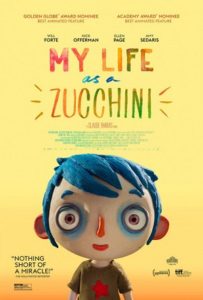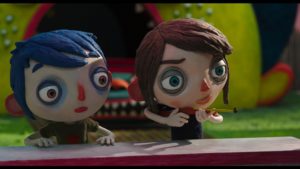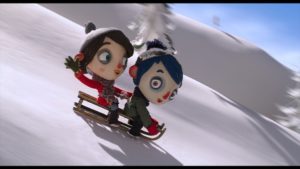 My Life as a Zucchini, a French stop-motion animation film based on a novel by Gilles Paris, is one of the best animated films from last year. It was nominated for an Academy Award, a Golden Globe, and scads other international awards. With themes and tone reminiscent of a Wes Anderson film (particularly Moonrise Kingdom), My Life as a Zucchini is a simply sweet and heartwarming story about community, adoption, and finding family.
My Life as a Zucchini, a French stop-motion animation film based on a novel by Gilles Paris, is one of the best animated films from last year. It was nominated for an Academy Award, a Golden Globe, and scads other international awards. With themes and tone reminiscent of a Wes Anderson film (particularly Moonrise Kingdom), My Life as a Zucchini is a simply sweet and heartwarming story about community, adoption, and finding family.
When Zucchini’s alcoholic mother dies in a freak accident (for which he blames himself), Zucchini is taken to a children’s home (his father having run off we don’t know how long ago). Thankfully, the adults who are around Zucchini in his new life–Raymond the police officer, the headmistress, the teachers–are all much kinder than Zucchini’s mother was. All of the children in the home have sad stories: parents with mental illness or drug problems, parents who are in jail, abuse, traumatic incidences–the list goes on. As Simon, the school’s resident tough guy, says, “We’re all the same. There’s nobody left to love us.” When a new girl, Camille, is brought to the home, Zucchini is instantly taken with her. Not only does Camille not take any crap from Simon, but she has her own tragic history, just like Zucchini. Life at the home is relatively pleasant–certainly better than where any of the children came from–but not without its trials. Time and time again, the children look out for one another; they become a close-knit family. Throughout the story, this family grows and changes, and eventually branches out, but this family they have been adopted into is far more loving than the biological families of each of the children.
 Psalm 68:5 says that God is “A father of the fatherless,” and My Life as a Zucchini creates a beautiful picture of that–particularly at the end when Raymond adopts Zucchini and Camille. Furthermore, I don’t think it’s much of a stretch to say that this little community of children gives us a picture of the body of Christ, even with their individual flaws (or maybe especially with their flaws). I Corinthians 12 says that God has composed the body of Christ “so that there may be no division in the body, but that the members may have the same care for one another. And if one member suffers, all the members suffer with it; if one member is honored, all the members rejoice with it.” (v. 25-26) In spite of all the normal childish bickering and teasing, the children stick together–when one is sad or hurting, they all suffer; when one has reason to celebrate they all rejoice. This also extends to the adults at the school (the headmistress and the teachers) as well as the police officer, Raymond. They all really do act like a family–like one body–flaws and all.
Psalm 68:5 says that God is “A father of the fatherless,” and My Life as a Zucchini creates a beautiful picture of that–particularly at the end when Raymond adopts Zucchini and Camille. Furthermore, I don’t think it’s much of a stretch to say that this little community of children gives us a picture of the body of Christ, even with their individual flaws (or maybe especially with their flaws). I Corinthians 12 says that God has composed the body of Christ “so that there may be no division in the body, but that the members may have the same care for one another. And if one member suffers, all the members suffer with it; if one member is honored, all the members rejoice with it.” (v. 25-26) In spite of all the normal childish bickering and teasing, the children stick together–when one is sad or hurting, they all suffer; when one has reason to celebrate they all rejoice. This also extends to the adults at the school (the headmistress and the teachers) as well as the police officer, Raymond. They all really do act like a family–like one body–flaws and all.
In addition to the film’s thematic beauty, the design and the animation are beautiful as well. The way the characters and environments are designed is charming and unique–and a little reminiscent of a child’s drawings. And the animators achieved astonishingly subtle expressions on the characters’ faces.
 In American culture we have come to equate animated movies with children’s movies: if it’s animated, it’s for kids. In other parts of the world, animation is an art form unrelegated to a specific demographic. Though My Life as a Zucchini IS animated, and many of the characters are children, the film is full of heavy subject matter and contains some more mature content. Be advised, this movie is rated PG-13 for good reason. And while I typically prefer to watch foreign films in their original languages, the English dub with Nick Offerman, Ellen Page, Amy Sedaris, and Will Forte is well worth the watch. My Life as a Zucchini is now available on Blu Ray and digital, so check it out and prepare for “all the feels.”
In American culture we have come to equate animated movies with children’s movies: if it’s animated, it’s for kids. In other parts of the world, animation is an art form unrelegated to a specific demographic. Though My Life as a Zucchini IS animated, and many of the characters are children, the film is full of heavy subject matter and contains some more mature content. Be advised, this movie is rated PG-13 for good reason. And while I typically prefer to watch foreign films in their original languages, the English dub with Nick Offerman, Ellen Page, Amy Sedaris, and Will Forte is well worth the watch. My Life as a Zucchini is now available on Blu Ray and digital, so check it out and prepare for “all the feels.”

